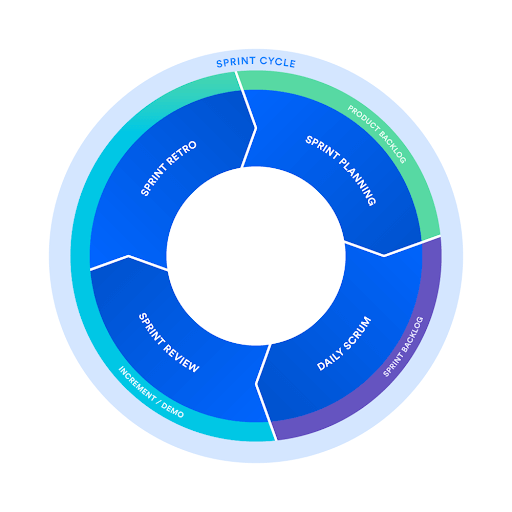Scrum artifacts
Product Backlog: master list of todo, features, bugs, chores for a product (calendar in this case)
Sprint Backlog: agreed upon list of items, user stories, or bug fixes, selected by the development team for implementation in the current sprint cycle
Sprint Cycle: agreed upon length of time where ship happens and sprint ceremonies take place
Sprint Ceremonies:
Scrum has these actors:
The scrum master
Scrum masters are the champions for scrum within their teams. They coach teams, product owners, and the business on the scrum process, and look for ways to fine-tune their practice of it.
The scrum development team
The guys that get s*%& shipped; done. They are are the champions for sustainable development practices. The most effective scrum teams are tight-knit, co-located, and usually five to seven members
The Business
The role of the business (business owner) is used in order to discuss the Scrum Team’s relationship with its Organization. The Business Owner refers to the person (or people) the Product Owner is (directly) accountable to for the Team’s Work Results, and who often provides resources and assistance to the Team.
Both the Scrum Master and the Product Owner have a relationship with the Business Owner. The ScrumMaster works with the Business Owner in order to help manage organizational impediments and constraints so that the Team can be more productive. The Product Owner works with the Business Owner in order to:
- Determine the priority of up-coming work in the Backlog;
- Consolidate the disparate needs of the Stakeholders;
- Modify the Release Plan as necessary and
- Get resources for the Team.
Product Owner
The Scrum product owner is typically a project’s key stakeholder. Part of the product owner responsibilities is to have a vision of what he or she wishes to build, and convey that vision to the scrum team. This is key to successfully starting any agile software development project.
Customer
Customer is the person or committee who has best of knowledge about the product. They directly report to the product owner and scrummaster any requests that need to be fixed, implemented, or changed and have the most stake in the product. A product owner is this voice for the customer doing scrum ceremonie and is the person whom represents the desires of customer in the product backlog.
Customers do not need to be apart of the sprint ceremonies but the product owner should.
Scrum has theses ceremonies
Scrum ceremonies are typically short meetings (25min per project) to address items in the backlog, items on the kanboard, and items with-in the team such as retrospectives. A daily or weekly standup usually is schedule to address blockers, and status updates.
Sprint Retrospective
- Team collectively answers:
- What could have improved?
- What went well?
- Typically follows or proceeds the backlog grooming and sprint review as part of the same meeting
Standup (aka daily scrum / weekly scrum)
- Development team reports on efforts and blockers, individuals answers:
- what they worked on (issue ticket / pull request number)
- what they’re working on this sprint/day (issue ticket / pull request number / one sentence statement of effort plan)
- Any blockers ( blockers are tabled to be addressed by individual and scrum master )
Sprint Planning
-
Development team, product owner, and scum master all agree on items to pull into the sprint backlog.
Development team leads this with the scrum master signing off on items priority and capacity -
Product owner signs off on items to be brought into the sprint
Backlog grooming and Sprint review
- Development team takes this time to demo the results of the sprint to the Stakeholders( product owners, business, customers )
- Lots of items gets put into the backlog this is where the product owner brings ups new items from customers and the business to be put in the backlog and where working with the scrum master items either get moved to the icebox (a bucket list of items that would be nice to do but not prioritized and can be visited at any point in the future), brought into the backlog or closed/rejected completely.

